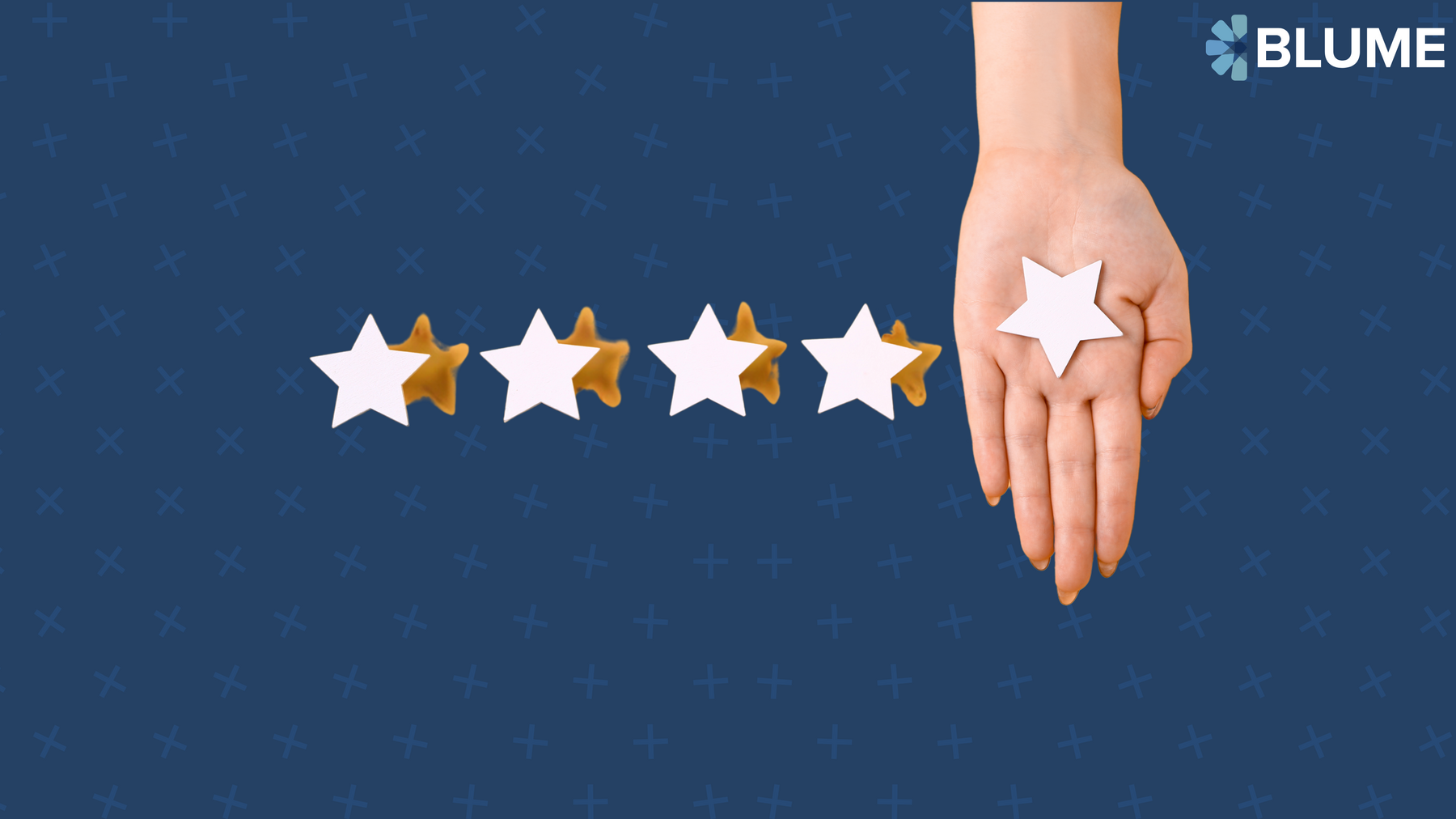If I tell you that there’s a way to increase your app install campaign's conversion rate by 89%, will you sit up and take notice?
What if I add that it has nothing to do with the design of your Instagram ad, your ad copy, or how you optimize your targeting?
Research by AppsFlyer says that moving your app’s rating to 4 stars from 3 stars can lead to an 89% increase in conversions. In a slightly older research, Paul Medrano, a growth marketing expert, asserted that going from a rating of 3.9 to 4.2 (just a 7.5% increase) improves conversion rate by over 30%.
There are other benefits of high app ratings and reviews:
- Discoverability: App store algorithms factor ratings and reviews when determining an app’s visibility in search results. SEMrush found that an app with more reviews is likely to appear higher in app store searches, improving the chances of being downloaded.
- Investor interest: If you are raising money, be assured that your investors will check your app’s rating while making their decision. For investors, high app store ratings can be a key indicator of the app's market acceptance and potential for growth.
With so much anchored on ratings and rankings, it is no surprise that app developers don’t spare any effort in persuading users to rate them on Apple’s App Store and Google’s Play Store. However, just popping up an in-app dialogue that says ‘rate the app’ as soon as someone downloads it and opens it up for the first time will not cut it for you.
In this article, I look at organic, non-paid ways to boost your app’s ratings and reviews, including how to earn the right to ask your users for ratings, creative ways to nudge them, and scaling the ratings and review program. Let’s go.
Why bother about organic ratings at all?
Whenever you first think about your app’s rating, this should be the first question to ask - pursue organic ratings or opt for paid ratings and reviews? There are pros and cons to both, and to say that paid reviews are evil is good virtue signaling but a poor business practice.
Rohit Sharma, co-founder of CellFish, a GenAI B2B2C consumer aggregator platform, highlights a major downside of paid reviews early in an app’s journey: they distract you from understanding your customers' real issues.
In the first 6 to 12 months, you need a tight feedback loop with your users to identify all the core and edge use cases where your app fails. Ratings/reviews on app stores are the primary ways for users to share these issues directly with you. While you can buy paid reviews to temporarily obfuscate these ratings on your app’s store page, it will not help you improve your app.
Once you decide to go ahead with the organic route to boost your app’s rating/review, the big question is - what to do next? Here’s a three-step framework to think about boosting your app’s ratings:
- Earning the right to ask for ratings.
- Creatively nudging users for feedback.
- Establishing a repeatable and scalable process.
Let's break this down further.
Earn the right to ask for a rating
Find your users at the aha moment
Vinay Singhal, co-founder and CEO of Stage, India’s leading regional OTT app, believes the perfect time to ask for a review is at the 'true Aha moment of value delivery.' At Stage, they've pinpointed this moment.
Vinay: “In our case, value is delivered through the content our users consume on our app. So, when they've fully consumed a unit of content, like watching a movie to the end, it signals they truly enjoyed it. That's the true 'aha' moment for us. If they hadn't enjoyed the movie, they would've dropped midway. Therefore, we approach our users for ratings only after they've finished consuming 100% of a movie.”
"Your app may have a different value delivery mechanism and a distinct aha moment, which you can identify by mapping user journeys. The key takeaway is to be honest about your app's value and approach users with a rating request only after they've reached that 'aha' moment. Annoying users with premature rating pop-ups degrades the user experience.
Nitin Agarwal, co-founder of UpScalio and a seasoned marketing leader, adds more nuance to this approach. He says, “App users come in a bell-shaped curve, ranging from light to heavy. If you ask everyone for ratings, you'll end up with an average of their experiences—basically, an average rating. But, if you focus on your top 10% to 20% of users first, those who really use and love your app, they're way more likely to drop a 4-star or 5-star rating.”
This means you should tag the top 20% of users in your system and reach out to them right at their 'aha' moment to build a strong foundation for your rating program.
Convert the nay-sayers
You can also engage users at the opposite end of the spectrum—those who have left 1-star and 2-star ratings—to convert them into higher ratings. While this task might appear daunting, it offers dual benefits: if executed properly, not only does it improve your ratings, but it also provides a window into your app’s issues, allowing you to improve your app. Rohit Sharma explains how they did this at CellFish.
Rohit: “While App stores will not pinpoint users who left a 1 or 2-star rating/negative review, we built an in-house system to triangulate data and identify such users with pretty good accuracy. We reached out to them with a simple message, usually on WhatsApp, given our target persona: “Hey, you installed our app, and you've been using it for a day. How do you find it?” The user shouldn’t feel that you are reaching out to them because they gave a poor rating, or else they will shut you out.”
“When users shared their issues, we quickly passed the feedback to our engineering team, who solved it in the next release or even before it if it is not linked to the front-end. We then let the user know we had fixed the issue, explaining that we're a new app actively working to enhance the customer experience. After they saw their concern was addressed, we felt we had earned the right to suggest they update their rating. However, we never directly asked for a higher rating; we simply inquired if they would consider revising it. You’ll be surprised how many people would go back and change a 1 or a 2-star rating to a 4-star one.”
“In fact, in some cases where a user helped flag a bug, we actually shared a small bug-finding fee with them and gave them credit for finding the bug.”
Central to this approach is a tech stack that lets you identify users who have left low ratings, as Google Play Store will not identify such users. Rohit unpacks how they set it up (and how you can, too!).
Rohit: “As an app developer, you can access a wealth of statistics in the Google Play Store console. There, you can download CSV files of all ratings and reviews, then analyze them by various dimensions—such as device, Android version, and app version.”
“Your engineering team can write scripts to automate the download of these CSV files daily and compare today's data with yesterday's. This comparison reveals the cohort of users who've given new ratings and reviews in the last 24 hours, along with identifiable markers like the Android model, device model, and app version.”
“And then, if you're collecting enough data on your app usage, you can look at when a user installed the app, time of review, how long they have used your app, etc. You can triangulate your rating data with the app usage and app install data from the last 24 hours to map users in your app to the ratings/reviews on the app store.”
“If you build this process carefully enough, your system will be able to identify the potential target users, and in some cases, it will even point at them with 100% confidence that this is the user who provided a 5-star rating and this is the one who provided a 1-star rating.”
Naturally, one wonders if reaching out to users who have dunked on your app is worth the effort. Rohit says it definitely is! In his experience, 4 out of 5 people updated their ratings after their issues were resolved, a staggering 80% success rate.
Nudge users creatively
How to reach your users
Vinay highlights WhatsApp is their most effective channel for soliciting ratings and reviews for several reasons:
- Their app primarily serves tier 2 and tier 3 cities, where users are more active on WhatsApp than email.
- WhatsApp enables real-time, interactive communication, offering a quicker response than SMS short codes.
- It allows for sending rich media messages, including direct links to the Play Store, simplifying the review process.
The economics of WhatsApp also work well. WhatsApp messages have 80% open rates, much higher than email or SMS. At Rs 0.90 per WhatsApp message, with even a 1% conversion from a message to a rating, the cost of a rating comes out to be Rs 90. This is way more economical than paid reviews, which cost Rs 100 to Rs 200, depending on your app’s category and scale. At higher conversion rates, the cost per rating comes down dramatically.
Nitin suggests that in-app messages and notifications are also a great way to reach users and agrees that emails do not work in India. He points out that while in-app communication is cost-free, WhatsApp's effectiveness and ROI justify its high costs. He advises doing the ROI maths and using WhatsApp for the most important consumer communications with only the critical cohorts.
How you ask matters as much as when you ask
Directly asking your users with a generic ‘please rate us’ copy seldom works. Think about it. How often do you rate an app when you receive such a generic pop-up or WhatsApp message?
Think of your nudge as another way to delight your users, not just another mass message like those bulk SMS blasts. Without the right degree of delight through personalization, you will not be able to get the attention of even your most loyal users. For instance, Stage sends customized WhatsApp messages indexing on the movie a user just finished to get the user’s attention.
Nitin suggests appealing with empathy when asking your users for ratings. “You need to be persuasive in your communication to get the user to spend 10 extra seconds for the Play Store rating. Experiment with catchy copies like, Show us some love and please take a moment to rate us on the Play Store or Your ratings would go a long way to make us feel good about the effort we put in to perfect your experience.”
You can also take personalization to the next level, similar to Spotify's Wrapped feature. It's tailored for you, and through this, Spotify earns the right to ask for a review. Likewise, Zomato sends out unique notifications, like “You are India's top 1% of Biryani or Chinese food lovers.” These gestures delight customers beyond the app's basic use, increasing the likelihood that they'll invest the time to rate your app.
Another benefit of personalization is to nudge users to leave a review on top of a rating. This is what Stage does.
Vinay: “We don't directly ask users to rate the app; instead, we connect the request to the movie they've just watched. For example, after someone watches Dada Lakhmi, we send a message: "Thank you for watching Dada Lakhmi. How did you like the movie?" We anchor the review request to the content. So, when the user goes to the Play Store, they not only rate the content (which reflects on the app's rating) but also leave a review with specific keywords, like "Dada Lakhmi," aiding in App Store Optimization.”
Make app ratings program scalable
Rohit from CellFish strongly recommends treating ratings not as a project but as an ongoing program integrated into the KRAs of the appropriate team, starting as soon as you launch on the app store. The logic is straightforward: your app doesn't receive low ratings sporadically or in isolated instances, does it? Unhappy users leave poor ratings and reviews daily. To counteract this, an always-on program is essential.
The core tech stack can be quite simple. App developers can integrate tools such as Amplitude into their apps and link 'aha moments' in user journeys to specific events within Amplitude. For example, in the case of Stage, the event could be a user completing 100% of a movie. When this event is triggered, it prompts a ping to platforms like CleverTap or WebEngage, which sends users an in-app message/notification or a message through WhatsApp.
The human touch here is critical. You should have a team staffed to engage with the users as soon as you release your app. While the technology automates messaging, a dedicated 'customer support' team scales the rating project by engaging with users who leave 1-star/2-star ratings and offering deeper engagement with the top 20% of users.
Rohit mentions that at Cellfish, they had a 2-member team very early on whose KRA was to drive ratings. There is no specific skill set needed for this role. Young, curious folks with strong communication skills are a good fit. You must train them well and ensure they have the right scripts when engaging with users.
He also recommends creating an internal app/portal that acts as the front end for all the data triangulation, reports, and message automation that the scripts are doing in the backend. Whenever a rating comes in, and the scripts identify the user, this app notifies the teams in real-time. The customer success and engineering teams should install this app on their phones to monitor incoming reviews and stay connected with how their app is used in the real world.
Rohit: “This ensures engineers realize they aren't working in isolation. Everything they do directly affects our sales, influences ratings, affects downloads, impacts conversions, and ultimately affects profitability.”
Lastly, carve out a budget for the ratings and review program. Apart from the cost of a customer success team (1 to 2 people at an early stage), tools like Amplitude and CleverTap/WebEngage, and any internal tools you make, there will also be a cost of using WhatsApp to communicate with users. Back-of-the-envelope calculations say that if you target 10,000 reviews monthly with a 1% conversion rate from the first message to a rating, you should budget Rs 9 to 10 Lakh monthly for WhatsApp.
Keep this in mind
- Depending on your customers, you may find some unique situations that can bump your ratings quickly. Rohit realized that their users (mostly from tier 2 and tier 3 cities) thought 1 was the highest rating. Consequently, even users who loved the app gave it a 1-star rating! The intervention by the customer success team quickly solved this.
- Regardless of the method—paid or organic—your app's ratings should appear credible. Ratings typically form a bell curve; If you artificially get too many 5-star ratings, users will feel something is fishy with your app, even though you have a high rating.
- When addressing 1-star or 2-star ratings, avoid insisting on a 5-star upgrade. If a user opts for a 4-star rating after an issue is resolved, happily accept it, thank them, and move on. This also keeps your rating distribution realistic.
- Success rates in improving ratings can differ by app category and size, but generally, only a low single-digit percentage of nudged users will change their rating. The maths is simple - your bottom 20-30% cohort will not rate or give you a low rating. Your top 20% of users might show a 5 to 6% conversion rate, while the middle 60% might convert at 2-3%, leading to an overall conversion rate of 2% to 3%. While improvements are possible, expecting a tenfold increase is unrealistic.
PS: Many thanks to Vinay, Rohit, and Nitin for their time and for sharing their knowledge candidly with us.






